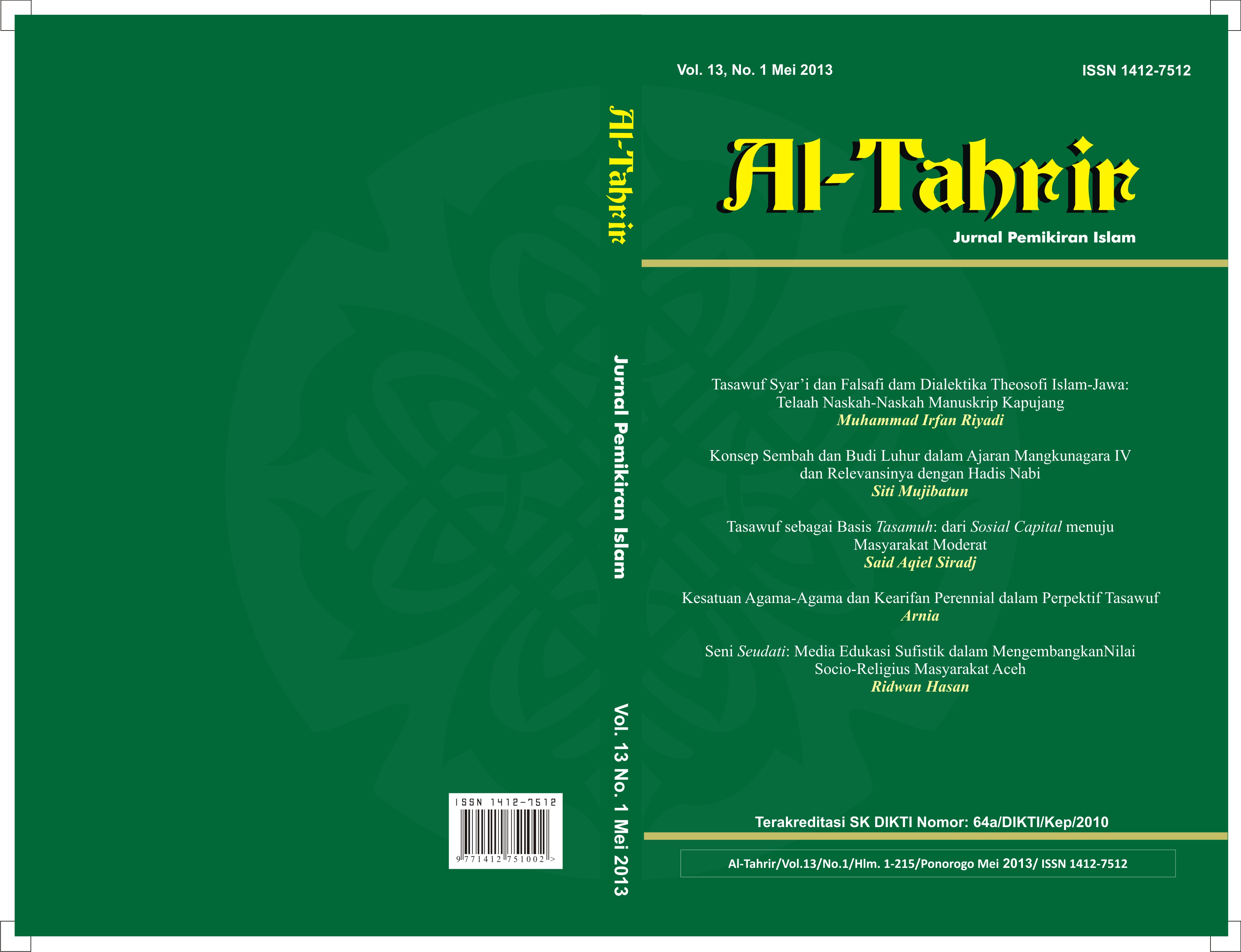Hulul, Ittihad, dan Wahdat al-Wujud dalam Perbincangan Ulama Zahir dan Batin
DOI:
https://doi.org/10.21154/al-tahrir.v13i1.9Abstract
Abstract: When prophet Musa, prayed to Allah , he requested to be able to see Him directly. But when he was shown to a mountain , he saw the mountain blasted and crushed and he was thrown away and fainted. Allah is not to be seen physically (Sufi metaphysics and gnosis (al-ma’rifah, ”˜irfan), because physical appearance we can see, sometimes, can make a bias to our perception and make our decision wrong.. To be close to Allah forever in such a way can not be easily reached not only because of limited abilities of our senses but also because all decision we have made are as the product of empirical, and descriptive rationality, while Allah is the most absolute existence of the Supreme Being. Thus, to be close to Allah through senses means to restrict His absolute Almighty God as the Supreme Being, to narrow His traits of God and to reduce His soul of absoluteness. However, it does not mean that to communicate with Allah (the experience of mystical union or direct communion with ultimate reality), is like to communicate in an empty tube, “.. In fact, there are many scholars of mysticism (Sufism) who can tell their spiritual experiences about the greatness and dignity of God through meditation and spiritual insight (Mujahadah, muqarabah, and muraqabah) where Islamic mysticism seeks to evaluate, contemplate and purify the human soul. Their spiritual experience in peace and harmony with God the Al-mighty is called hulul, ittihad and wahdat al-wujud. The differences of experience between both rational and intuitive reasoning causes human tragedy to the scholars of mysticism like al Hallaj, al-Suhrawardi, and Shekh Siti Jenar.. Actually, this conflict should not happen if each side could keep their emotion academically, and respect their differences each other. Why? Because this conflict, eventually, causes the development of Islamic science become stagnancy like today.
Downloads
Downloads
Published
Issue
Section
License
Please find the rights and licenses in Al-Tahrir. By submitting the article/manuscript of the article, the author(s) agree with this policy. No specific document sign-off is required.
1. License
The non-commercial use of the article will be governed by the Creative Commons Attribution license as currently displayed on Creative Commons Attribution-NonCommercial 4.0 International License.
2. Author(s)' Warranties
The author warrants that the article is original, written by stated author(s), has not been published before, contains no unlawful statements, does not infringe the rights of others, is subject to copyright that is vested exclusively in the author and free of any third party rights, and that any necessary written permissions to quote from other sources have been obtained by the author(s).
3. User/Public Rights
Al-Tahrir's spirit is to disseminate articles published are as free as possible. Under the Creative Commons license, Al-Tahrir permits users to copy, distribute, display, and perform the work for non-commercial purposes only. Users will also need to attribute authors and Al-Tahrir on distributing works in the journal and other media of publications. Unless otherwise stated, the authors are public entities as soon as their articles got published.
4. Rights of Authors
Authors retain all their rights to the published works, such as (but not limited to) the following rights;
- Copyright and other proprietary rights relating to the article, such as patent rights,
- The right to use the substance of the article in own future works, including lectures and books,
- The right to reproduce the article for own purposes,
- The right to self-archive the article,
- The right to enter into separate, additional contractual arrangements for the non-exclusive distribution of the article's published version (e.g., post it to an institutional repository or publish it in a book), with an acknowledgment of its initial publication in this journal (Al-Tahrir).
5. Co-Authorship
If the article was jointly prepared by more than one author, any authors submitting the manuscript warrants that he/she has been authorized by all co-authors to be agreed on this copyright and license notice (agreement) on their behalf, and agrees to inform his/her co-authors of the terms of this policy. Al-Tahrir will not be held liable for anything that may arise due to the author(s) internal dispute. Al-Tahrir will only communicate with the corresponding author.
6. Royalties
Being an open accessed journal and disseminating articles for free under the Creative Commons license term mentioned, author(s) aware that Al-Tahrir entitles the author(s) to no royalties or other fees.
7. Miscellaneous
Al-Tahrir will publish the article (or have it published) in the journal if the article’s editorial process is successfully completed. Al-Tahrir's editors may modify the article to a style of punctuation, spelling, capitalization, referencing and usage that deems appropriate. The author acknowledges that the article may be published so that it will be publicly accessible and such access will be free of charge for the readers as mentioned in point 3.







